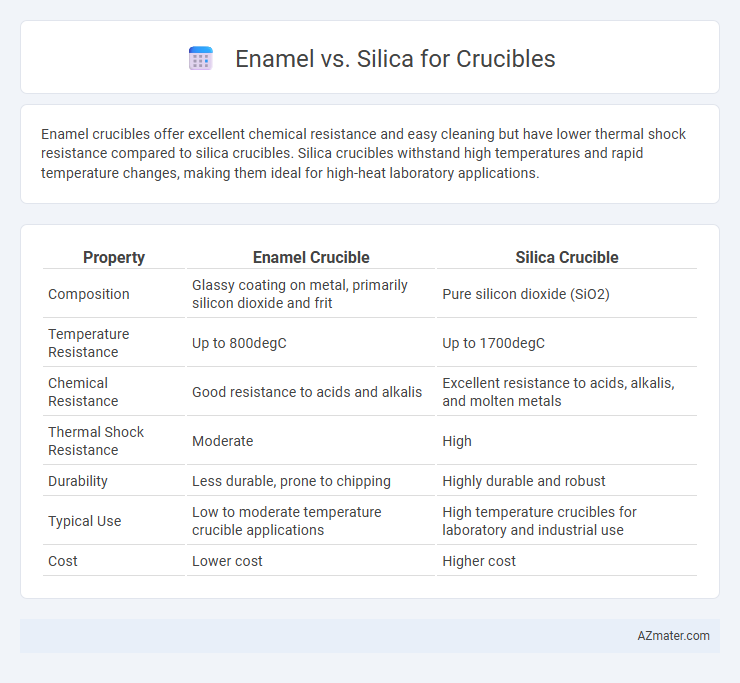Enamel crucibles offer excellent chemical resistance and easy cleaning but have lower thermal shock resistance compared to silica crucibles. Silica crucibles withstand high temperatures and rapid temperature changes, making them ideal for high-heat laboratory applications.
Table of Comparison
| Property | Enamel Crucible | Silica Crucible |
|---|---|---|
| Composition | Glassy coating on metal, primarily silicon dioxide and frit | Pure silicon dioxide (SiO2) |
| Temperature Resistance | Up to 800degC | Up to 1700degC |
| Chemical Resistance | Good resistance to acids and alkalis | Excellent resistance to acids, alkalis, and molten metals |
| Thermal Shock Resistance | Moderate | High |
| Durability | Less durable, prone to chipping | Highly durable and robust |
| Typical Use | Low to moderate temperature crucible applications | High temperature crucibles for laboratory and industrial use |
| Cost | Lower cost | Higher cost |
Introduction to Crucible Materials
Crucibles are essential containers used in high-temperature metal melting and chemical reactions, requiring materials with excellent thermal resistance. Enamel provides a smooth, non-porous coating that enhances corrosion resistance and durability in lower temperature applications, while silica crucibles offer superior thermal shock resistance and purity, making them ideal for high-temperature processes above 1600degC. Choosing between enamel and silica depends on the specific thermal requirements and chemical compatibility needed for the crucible's intended use.
Overview of Enamel Crucibles
Enamel crucibles are crafted by coating metal or ceramic bases with a smooth, glassy enamel layer that provides exceptional chemical resistance and durability. These crucibles excel in handling high-temperature processes, resisting corrosion from acids and alkalis, and preventing contamination of samples. Their thermal stability and inert surface make them ideal for precise laboratory applications compared to silica crucibles, which often offer higher melting points but lack the same chemical inertness.
Overview of Silica Crucibles
Silica crucibles, primarily composed of high-purity silicon dioxide, offer exceptional thermal shock resistance and can withstand temperatures exceeding 1700degC, making them ideal for high-temperature laboratory applications. Their chemical inertness ensures minimal contamination during processes involving aggressive substances, providing reliable performance in glassmaking, metal melting, and ceramics firing. Compared to enamel crucibles, silica crucibles exhibit superior durability under extreme thermal cycles, although they are more brittle and require careful handling to prevent mechanical damage.
Thermal Resistance Comparison
Silica crucibles exhibit superior thermal resistance with melting points around 1723degC, making them ideal for high-temperature applications and rapid heating cycles. Enamel crucibles, typically made by coating metal with glassy enamel, withstand temperatures up to approximately 800degC but are prone to cracking under thermal shock. The thermal stability of silica ensures consistent performance in high-heat industrial processes, while enamel's thermal limitation restricts its use to moderate temperature ranges.
Chemical Reactivity and Inertness
Enamel crucibles exhibit high chemical inertness due to their vitreous coating, which resists most acids and alkalis, making them ideal for handling corrosive substances without contamination. Silica crucibles provide excellent chemical stability at high temperatures but are more reactive with strong alkalis and molten metals, potentially leading to surface degradation. Their contrasting chemical reactivity profiles determine their suitability for specific high-temperature applications in laboratories and metallurgy.
Durability and Lifespan
Enamel crucibles offer moderate durability with resistance to chemical corrosion but are prone to chipping and cracking under thermal shock. Silica crucibles provide superior lifespan due to their high thermal stability and resistance to thermal shock, making them ideal for high-temperature applications. The enhanced durability of silica results in reduced maintenance and replacement frequency compared to enamel varieties.
Cost and Accessibility
Enamel crucibles generally offer a lower upfront cost and easier accessibility due to widespread availability in hardware and laboratory supply stores. Silica crucibles, although more expensive, provide superior thermal resistance and durability, justifying their higher price in specialized applications. Cost efficiency for enamel suits general use, while silica's premium pricing aligns with high-temperature, critical processes.
Applications in Laboratories and Industry
Enamel crucibles offer excellent chemical resistance and thermal stability, making them ideal for laboratory applications involving high-temperature reactions and sample melting. Silica crucibles provide superior high-temperature durability and purity, preferred in industries such as metallurgy and ceramics for processes requiring contamination-free environments. Both materials excel in thermal shock resistance, but silica's inert nature makes it the standard choice for analytical chemistry and high-precision industrial processes.
Safety Considerations
Enamel crucibles offer excellent chemical resistance and smooth surfaces that minimize contamination risks, ensuring safe handling of acidic or corrosive materials. Silica crucibles withstand extremely high temperatures and thermal shock well but can pose a higher risk of breakage and particulate release if mishandled, requiring careful temperature control and protective equipment. Selecting between enamel and silica depends on the specific chemical compatibility and temperature stability necessary to maintain laboratory safety standards.
Choosing the Right Crucible for Your Needs
Choosing the right crucible depends on the material compatibility and temperature requirements, with enamel crucibles offering excellent chemical resistance and easy cleaning for lower temperature tasks up to 900degC. Silica crucibles excel in high-temperature applications above 1400degC due to their superior thermal stability and resistance to thermal shock, making them ideal for metal melting and high-temperature laboratory work. Consider the specific melting point, chemical reactivity, and thermal conductivity needed to ensure optimal performance and longevity of the crucible in your processes.

Infographic: Enamel vs Silica for Crucible
 azmater.com
azmater.com